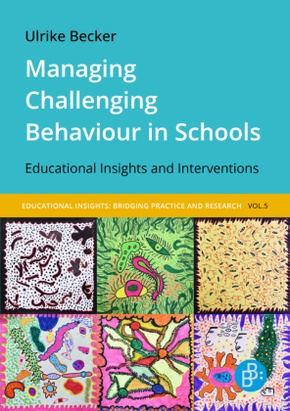Managing Challenging Behaviour in Schools - Educational Insights and Interventions
| Verlag | Verlag Barbara Budrich |
| Auflage | 2025 |
| Seiten | 113 |
| Format | 14,9 x 0,5 x 21,1 cm |
| Gewicht | 170 g |
| Artikeltyp | Englisches Buch |
| Reihe | Pädagogische Einsichten: Praxis und Wissenschaft im Dialog 5 |
| ISBN-10 | 3847431072 |
| EAN | 9783847431077 |
| Bestell-Nr | 84743107A |
Auffälliges Verhalten von Kindern und Jugendlichen im schulischen Alltag zeugt oftmals von den schwierigen Lebenssituationen, in denen sie aufwachsen. Für Lehr- und pädagogische Fachkräfte stellt der Umgang mit den daraus resultierenden Konflikten die größte Herausforderung dar. In diesem Buch werden Ansätze und Lösungen für das Verstehen und Handeln in schwierigen pädagogischen Situationen in der Schule vorgestellt. Außerdem bietet ein inklusiver Förderansatz Impulse für die Schulentwicklung zur Prävention auffälligen Verhaltens.
Challenging behaviour of children and adolescents in everyday school life is often a sign of the difficult life situations in which they grow up. For teachers and educational professionals, dealing with the resulting conflicts is the biggest challenge. This book presents approaches and solutions for understanding and acting in difficult educational situations at school. In addition, an inclusive support approach offers impulses for school development to prevent challenging behaviour.
Inhaltsverzeichnis:
Introduction1. Education in times of social crisis1.1 Psychosocial situation of children and adolescents against the background of social crises1.2 School as a resilience factor1.2.1 Classroom teaching1.2.2 (Digital) learning at a distance1.2.3 Closeness and distance in the educational relationship1.3 Conclusion2. Pupils with aggressive behaviour: Behaviour towards teachers2.1 Theoretical considerations2.2 Educational attitude2.3 Cuts as solutions in everyday school life2.3.1 Reset2.3.2 From confrontation to closing unity2.3.3 Paradoxical intervention2.3.4 Redirect2.3.5 Going out2.3.6 Safe storage of dangerous objects2.3.7 Place swap2.3.8 Individual work order2.3.9 Time Out2.3.10 Trigger acoustic signal2.4 Reparation instead of punishment2.5 Conclusion3. Pupils harm others3.1 Theoretical considerations3.2 Solutions for conflicts in everyday school life3.2.1 Reactivation of sibling conflicts3.2.2 Neglect3.2.3 Bullying3.2.4 Stigmatisation3.2.5 Discrimination because of clan family n ames3.2.6 Non-compliance with rules of faith3.3 Conclusion4. Pupils harm themselves4.1 Theoretical considerations4.2 Solutions for conflicts in everyday school life4.2.1 Sensory overload4.2.2 Separation anxiety4.2.3 Self-harming behaviour such as scratching4.2.4 Hyperactivity4.2.5 Individual retreat4.2.6 Blows to your own body4.3 Conclusion5. Parents who are difficult to reach5.1 Legal framework for working with parents5.2 Effect of parents on children s behaviour5.3 Hard to reach parents5.3.1 Causes of difficult accessibility5.3.2 Solutions for conversations with parents5.4 Conclusion6. Prevention of challenging behaviour and conflicts6.1 Prevention of challenging behaviour6.2 School policy6.3 School rules6.4 Conclusion7. Learning accesses for pupils with special needs in their emotional and social development7.1 Inclusive and exclusive currents7.2 Transition project7.2.1 Theoretical background7.2.2 Study results7.2.3 Internal school organisation7.2.4 Exchange and dissemination7. 3 Five learning accesses7.3.1 Temporary learning group7.3.2 Inclusive teaching7.3.3 Counselling in a multi-professional team7.3.4 Counselling with parents7.3.5 Cooperation between schools and youth welfare services7.4 Conclusion8. Summary and outlook8.1 Summary8.2 OutlookLiteratureIndex

